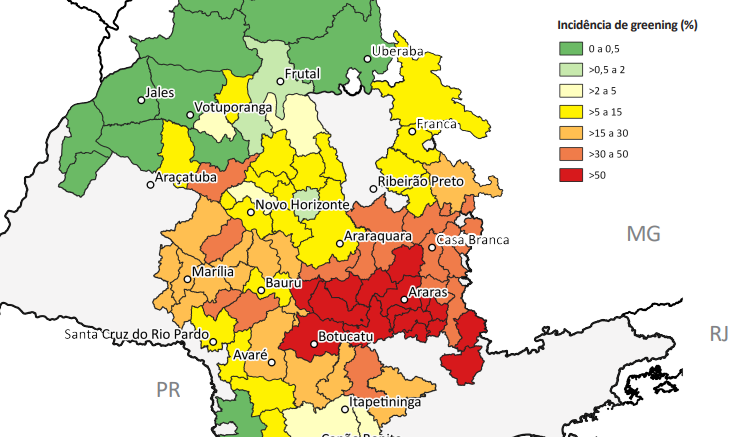“The expansion of the citrus belt is not a palliative, but a consequence of greening…”
Ibiapaba Netto is the executive director of the National Association of Citrus Juice Exporters – CitrusBR, a graduate in communications and media studies from FIAM, with an MBA from the Getúlio Vargas Foundation.

Ibiapaba Netto, executive director of CitrusBR
AgriBrasilis – Is the citrus belt expansion merely a palliative response to greening?
Ibiapaba Netto – The expansion of the citrus belt is not a palliative measure, but a consequence of greening.
This disease is not new to Brazil. Greening has been present here since 2004, and during this time, several technologies and management techniques have been developed that allow for safe production, as long as everything is done properly. The issue is that it took some time for these technologies and practices to become widely known.
In some regions, the incidence is very high, and in those areas, it’s not possible to reinvest in citrus farming since, after 4 to 5 years, the tree becomes unproductive. Considering an implementation cost of around US$ 20,000 per hectare, you can imagine the magnitude of the losses. Therefore, expansion is not a palliative measure, it is a consequence.
Now, these new citrus-producing regions are fully capable of maintaining healthier and longer-lasting production over time.
AgriBrasilis – What are these new regions and the consequences of this migration?
Ibiapaba Netto – The citrus belt has been growing in the State of Minas Gerais, which is already a relatively traditional region. Minas Gerais’ production has surpassed that of Florida in recent years, and it has been expanding into other parts of the State, especially in Santa Vitória and Prata.
In addition, there is also an expansion into the State of Mato Grosso do Sul, which is indeed a new region. We can say this is a new frontier for citrus farming, entering areas of pastureland, and soybean fields—areas that are already cleared and are now openeing to a new crop.
AgriBrasilis – What are the expectations for the 2025/26 Brazilian orange harvest?
Ibiapaba Netto – The 2025/26 orange yield will be announced by Fundecitrus on May 9th. Since Fundecitrus is the one that provides the estimate, CitrusBR does not take a position beforehand. Even so, we know it’s going to be a bigger harvest — better than the one that just ended, especially considering that it was the worst crop in more than 30 years.
So, the baseline is already very low, and any growth from here on out is welcome because we need to build up inventories. We need a greater availability of juice to ensure smooth operations throughout all the months of the season.
AgriBrasilis – What factors are driving the fluctuations in orange prices?
Ibiapaba Netto – Between 2023 and 2024, we saw a huge surge in prices for both orange juice and fruit, due to a supply shortage.
Now, the recent price drop—mainly from December 2024 onward—is due to two main factors: first, a decline in demand, which has been quite noticeable, especially due to those rising prices. When prices go up, consumers tend to switch to other products.
The second factor is the emergence of new products competing for the same consumers. We’ve seen reduced packaging sizes—used as an indirect price-increase transfer strategy—and the launch of new products, like diluted orange juice, or “multifruit” beverages where orange juice is just one ingredient rather than the most important product.
READ MORE:

